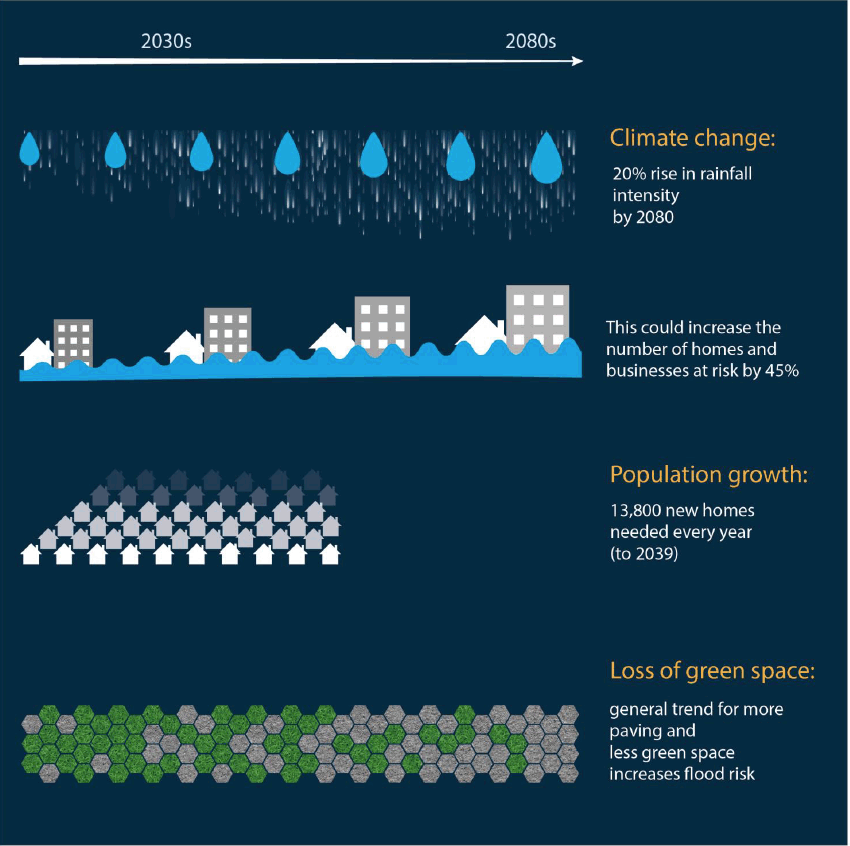Surface water management planning: guidance (2018)
Guidance to assist the responsible authorities in preparation of Surface Water Management Plans (SWMPs) to help with the management of surface water flooding.
1 Introduction
1.1 Purpose of the guidance
This guidance sets out the process that responsible authorities should follow when developing and implementing their Surface Water Management Plans ( SWMPs). SWMPs should reduce the risk of surface water flooding in the most sustainable way as required by the Flood Risk Management (Scotland) Act 2009 (the “ FRM Act”).
The principles advocated can be applied to manage surface water flooding in any area and at any geographical scale. Nevertheless, responsible authorities should prioritise planning in those areas identified through the Flood Risk Management Strategies ( FRM Strategies) and Local Flood Risk Management Plans ( LFRMPs) as being at greatest risk of surface water flooding.
This guidance has been developed by the Scottish Advisory and Implementation Forum for Flooding ( SAIFF), which includes representatives of Scottish Government, local authorities, Scottish Water and the Scottish Environment Protection Agency ( SEPA).
1.2 The flood risk management planning process
The FRM Act established a six-year cyclical planning process for assessing and sustainably managing flood risk. Its aim is to reduce the adverse consequences of flooding from all sources, including surface water flooding ( Figure 1.1). The FRM Act requires SEPA to produce FRM Strategies and lead local authorities to produce LFRMPs.
The FRM Strategies:
- Identify areas at greatest risk of river, coastal and surface water flooding in Scotland.
- Set objectives to reduce flood risk in those areas.
- Identify actions to achieve the objectives:
- Require responsible authorities to develop and implement SWMPs to reduce the risk of surface water flooding for areas of greatest risk.
- Describe any relevant actions that have been identified through the surface water management planning process to reduce surface water flood risk.
- Actions to reduce the risk of river and coastal flooding are also identified.
The first FRM Strategies published in December 2015 [1] identify around 100 towns and cities where SWMPs are required.
The LFRMPs set out the timescales for developing new SWMPs, reviewing existing ones and implementing actions identified. They also set out details for implementing actions to reduce the risk of river and coastal flooding.
Ministerial guidance on Delivering Sustainable Flood Risk Management [2] states that local authorities will lead on surface water management planning, which will in turn be co-ordinated through the flood risk management planning process.

Figure 1.1 Surface water flooding and the flood risk management planning process
1.3 Surface water flooding in Scotland
Surface water flooding is a significant problem in Scotland. The FRM Strategies published by SEPA in 2015 estimate that it is responsible for 23% of annual average flood damage (see Box 1.1 and Figure 1.2 for further information). Moreover, the risk of surface water flooding is likely to increase in the future as a result of climate change, the loss of green space in urban areas and, potentially, new development. It is therefore important that land use planning policies take such risks into account when considering new development ( Figure 1.3).
Box 1.1 Surface water flooding in Glasgow, 30 July 2002

Flooding in Cockenzie Street, Glasgow 2002.
Photograph courtesy of The Herald and Times.

Flooding in Ardgay Street, Glasgow 2002.
Photograph courtesy of Glasgow City Council.
Significant surface water flooding occurred in Glasgow on 30 July 2002, when around 75mm of rain fell in ten hours. The storm had a number of high intensity periods of rainfall interspersed with periods of low or no rainfall. Within the periods of high intensity rainfall, intensities equivalent to 94.5mm per hour were recorded (but for a very short period of time). This rainfall event was estimated to be a 1:100 year return period. Most of the resultant flooding was caused by surface water including surface water run-off, flooding from sewers and other artificial drainage systems and flooding from small urban watercourses.
The East End of Glasgow was the worst affected, with 200 people evacuated from their homes. Flooding and landslides disrupted rail travel, closing routes on the West Coast and Glasgow to Edinburgh via Carstairs lines as well as Queen Street station. A number of roads were also badly affected, including the A82 and A8. The cost of the damage was estimated to be in the region of £100 million.

Figure 1.2 Current surface water flood risk in Scotland (based on SEPA 2013 data)

Figure 1.3 Future surface water flood risk (based on SEPA 2013 flood risk data)
(projections for new homes based on National Records of Scotland data)
1.4 What is surface water flooding?
In natural (undeveloped) catchments, when rain falls some of the water will evaporate directly back into the atmosphere (evaporation) and some will infiltrate the ground; some of the latter will then be taken up by vegetation and evaporate back into the atmosphere (transpiration). Any excess surface water run-off will then drain, via a network of smaller drainage channels, watercourses and lochs, to the sea. During higher rainfall, watercourses can reach their bankfull capacity and overflow on to floodplains ( Figure 1.4).
Development and urbanisation has fundamentally altered this natural drainage process. Removing vegetation and building over green space reduces infiltration and evapotranspiration. This increases both the volume and rate of surface water run-off in urban areas. This increased run-off, combined with the replacement (or removal) of some watercourses and other natural drainage features with drains and culverts (that have a finite capacity), causes flooding, when surface water cannot reach watercourses or the drainage network, or when the drainage network capacity is exceeded. When the surface water run-off reaches watercourses, it can also exacerbate river flooding ( Figure 1.4).

Figure 1.4 Surface water run-off in natural and urbanised landscapes
The term surface water flooding is often used to describe flooding from high intensity rainfall, when surface water run-off flows and ponds on the ground and when sewers and other artificial drainage systems exceed their capacity. It is distinct from flooding that occurs from larger rivers and the sea. In reality the term is often a complex interaction of many sources of flooding, including flooding from natural (e.g. smaller watercourses) and artificial (e.g. sewers) drainage systems and direct inundation from surface water run-off. Other sources of flooding can exacerbate surface water flooding, for example where high sea or river levels prevent drainage systems from discharging freely.
For the purpose of this guidance, the term surface water flooding includes flooding from the following sources:
- Pluvial flooding – flooding as a result of rainfall run-off flowing or ponding over the ground before it enters a natural (e.g. watercourse) or artificial (e.g. sewer) drainage system or when it cannot enter a drainage system (e.g. because the system is already full to capacity or the drainage inlets have limited capacity).
- Flooding from sewers and other artificial drainage systems (when capacity is exceeded) – flooding as a result of the capacity of sewers or other artificial drainage systems (e.g. road drainage) being exceeded by rainfall run-off or because the drainage system cannot discharge water at the outfall due to high river or sea levels.
- In general Scottish Water is responsible for managing sewer systems that are designed to manage ‘usual’ rainfall (currently interpreted to mean up to the 1:30 year rainfall event). Surface water flooding under the FRM Act is flooding that occurs when the sewer capacity is exceeded (e.g. by higher than usual rainfall or when the sewer system is affected by high river or sea levels).
- Flooding from small urban watercourses (including culverted watercourses) – flooding that occurs from small watercourses (including culverted watercourses) that receive most of their flow from inside the urban area and perform an urban drainage function (it should be noted that SEPA does not currently assess fluvial flood risk from any watercourses with a catchment area less than 3km 2).
- Groundwater flooding – flooding as a result of the water table rising to the surface.
1.5 Sustainable surface water management
It is not possible to build underground urban drainage systems that are large enough to accommodate the most extreme rainfall events. Instead extreme rainfall and resultant surface water run-off must be managed safely above ground avoiding harm to people, homes, businesses and other adverse impacts of flooding.
Co-ordination between authorities using multidisciplinary teams (including landscape architects) is important to ensure that surface water management infrastructure integrates with and enhances the urban landscape. This is essential to ensure that management of surface water realises multiple benefits e.g. contributing to providing attractive and inviting places for people, managing rainfall and surface water flooding, reducing surface water in the sewers, improving the quality of the water environment, increasing biodiversity and making the urban environment more adaptable to future change. To help achieve this, the principles of sustainable surface water management set out in Table 1.1 should be followed (see examples in Figures 1.5, 1.6).
Good examples can be seen in Denmark and the Netherlands where landscape architects have led on the design of multifunctional urban landscapes using nature-based solutions that deliver these multiple benefits, including management of rain and surface water flooding (Boxes 1.2, 1.3).
Table 1.1. Principles of sustainable surface water management
| Manage rain and surface water in a way that mimics natural systems and protects and enhances both the built and natural environment. |
| Manage rainfall and surface water safely above ground, avoiding harm to people, homes, businesses and other adverse impacts of flooding. Maximise the use of permeable surfaces and plants and convey water to watercourses using the natural topography. Avoid increasing surface water in the sewers as this can lead to flooding elsewhere. Reduce surface water in the sewers where possible. |
Manage all rainfall events:
|
Multifunctional – maximise all benefits:
|
| Co-ordinate with other authorities and projects to maximise benefits and aid delivery (e.g. using foot paths and cycle paths as routes for infiltrating and conveying water, contributing to ‘green and blue networks’). |
| Think of different spatial scales required to manage surface water (e.g. what can be done locally at the building and street level, what regional and more strategic management is required and what connections between the different scales are required?). |

Figure 1.5 Principles of sustainable surface water management

Figure 1.6 Design for all rainfall events
Box 1.2 Copenhagen – providing a multifunctional urban landscape that includes management of rain and surface water flooding

Copenhagen climate change adaptation plan
http://en.klimatilpasning.dk/

Proposals for the Nørrebro neighbourhood of Copenhagen by SLA landscape architects
http://www.sla.dk/en/projects/hanstavsenspark
Images © SLA /Beauty and theBit
Box 1.3 Rotterdam - providing a multifunctional urban landscape that includes management of rain and surface water flooding

Rotterdam climate change adaptation
http://www.rotterdamclimateinitiative.nl/documents/2015-enouder/Documenten/20121210_RAS_EN_lr_versie_4.pdf
Photograph ©Ossip van Duivenbode

Water square in Benthemplein, Rotterdam by De Urbanisten landscape architects
http://www.urbanisten.nl/wp/
Image ©De Urbanisten
Contact
Gordon Robertson: Flooding_Mailbox@gov.scot
There is a problem
Thanks for your feedback